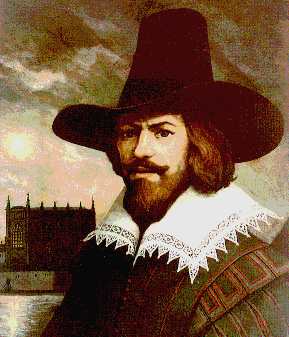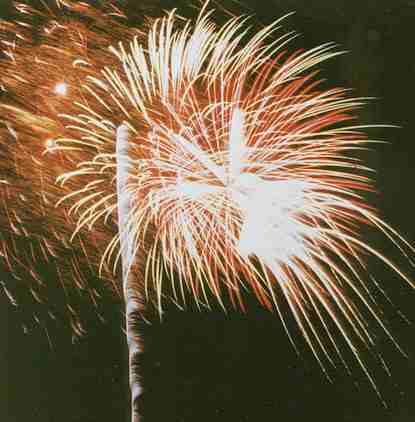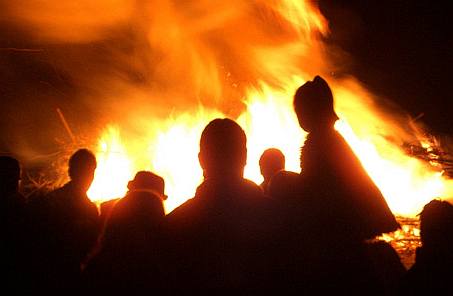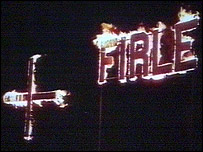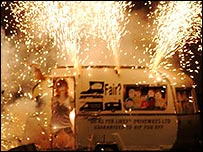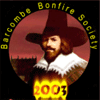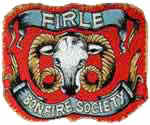|
BONFIRE NIGHT
|
||||||||||||||||||||||||||||||||
|
HOME | BIOLOGY | FILMS | GEOGRAPHY | HISTORY | INDEX | INVESTORS | MUSIC | SOLAR BOATS | SPORT |
||||||||||||||||||||||||||||||||
|
In 1605, Guy Fawkes and a group of conspirators attempted to blow up the Houses of Parliament. Before they were able to carry out their plan they were caught, tortured and executed. Every year since then we have traditionally celebrated his failure by letting off fireworks and burning an effigy of 'Guy'. There had been many many years of fighting between the Catholics and the Protestants. The Catholics regarded the Pope (in Rome) as the head of their Church, but the Protestants said that the head of the English Church was the King of England. By the time that James I, a Protestant, became King, the Catholics had been treated very badly and were restless. So it was that a Catholic called Robert Catesby decided to do something about it. He brought five men together and told them of his secret plan. One of the men was Guy Fawkes.
Guy Fawkes
THE PLOT
More Catholics joined the plotters, but as more men heard about the plot, it became harder to keep it secret. Eventually, someone sent a warning letter to one of the Members of Parliament and the plot was discovered. Soldiers were sent to the rented house and the cellars and found the gunpowder. They also found Guy Fawkes, waiting with matches ready to light the fuse which would make the gunpowder explode. He was arrested and horribly tortured to make him tell who else was involved. All the plotters were found guilty of treason and executed.
Fireworks display - starburst rocket
The Members of Parliament were so pleased they had not been blown up, they made a law that 5th November would be a day of thanksgiving and celebration, and that is why we have bonfires and fireworks on "bonfire night".
In
some ways Bonfire Night is related to the ancient festival of Samhain,
the Celtic New Year. Bonfires formed an important part of the Celtic New
Year celebrations - warding off evil spirits. Bonfires play a part in
many customs all over the world. On November 5th as part of Bonfire
Night celebrations we too light bonfires. What makes the British Bonfire
Night celebrations special is the burning of the guy. The guy is a
figure usually made by the children out of old clothes, papier mache and
anything else we can use. It represents Guy Fawkes and is burnt on the
bonfire. Sometimes in the week or so before Bonfire Night children will
take their guys on to the street and beg "a penny for the
Guy". The money then goes towards the fireworks.
Bonfire Night
Bonfires have long been used as an expression of rejoicing in England, particularly to mark victories or deliverances, either spontaneously or by being ordained by the authorities. They have also formed an integral part of particular calendar customs. The evolution of the English late-Autumn bonfire festivities is complex, with many strands woven into it. Some have attempted to trace it back to the Celtic festival of Samhain; others suggest that it is based upon the the custom of lighting bonfires to protect against disease, or to burn bones for fertilizer.
After the Gunpowder Plot of 1605, celebrations were held throughout the country on 5th November, encouraged by the Church of England and other authorities. Both Samuel Pepys and John Evelyn refer to the custom in their diaries. It is not clear why this habit of communal celebration died out (or dwindled into family bonfires with a few fireworks and maybe a Guy) in many areas, or why the tradition remained so strong in Sussex. Whatever the reason, the surviving Sussex celebrations degenerated into disorganised and drunken revelry, with houses being (accidentally or deliberately) burnt down. Often large numbers of local people were sworn in as special constables to control the Bonfire Boys, resulting in arrests and subsequent heavy fines or imprisonment. The formation of the original Bonfire Societies, to bring them into some kind of order, came none too soon.
SEVEN ARRESTS OVER BURNT GYPSY EFFIGY - 12 November 2003
Police have arrested seven people on suspicion of inciting racial hatred after a bonfire society torched an effigy of a caravan with a gypsy family painted on the side.
The tableau, which was burnt at Firle Bonfire Society's celebrations in East Sussex, caused outrage because of the controversial display.
The society denied any claims the caravan, which had P1 KEY written on the side along with a message which said "Do you as you likey Driveways Ltd - guaranteed to rip you off", was designed to be racist.
Firle bonfire party has been criticised
Four people were arrested by Sussex Police on Monday and then released on bail. A further three people were arrested on Tuesday and also released on bail until mid January.
A police spokesman said a total of 12 arrests were expected to be made by the end of this week. Those who were detained were questioned on suspicion of inciting racial hatred.
A police spokesman said a full file would be sent to the Crown Prosecution Service and then forwarded to the director of Public Prosecutions for considerations. It was an offence to stir up racial hatred through words or behaviour under the Public Order Act, the spokesman said.
Superintendent Grenville Wilson said: "We recognise the concerns being made across communities in East Sussex about events which happened at Firle. "A full, open and thorough investigations is in the process of being carried out, which will uncover all the issues in the case."
The bonfire society said the effigy was chosen after the village experienced difficulties with travellers over the summer. It has issued an unreserved apology to anyone who was offended by the effigy. Since the controversy the society has withdrawn from all other events in the Sussex bonfire calendar.
The Commission for Racial Equality has called for those involved in the effigy burning to be pursued and "punished".
POLICE INVESTIGATE BURNING OF EFFIGIES 29 October 2003
An investigation has begun after a caravan with effigies of Gypsies was burnt at a village bonfire party, Sussex police have said.
BBC South East Today revealed on Tuesday how residents were left shocked when the caravan was wheeled through a street in Firle, East Sussex, before being torched.
Trevor Phillips, chairman of the Commission for Racial Equality, called for those responsible to be prosecuted for incitement to racial hatred - an offence which can lead to a jail term of seven years.
On Wednesday, a Sussex Police spokesman said: "Police received no complaints about the nature of the tableaux paraded and burned at the celebrations, but in the light of the news item broadcast by the BBC an investigation has begun."
He added: "There is a tradition of bonfire celebration across East Sussex, organised by local bonfire celebrations.
"The nationally famous celebration at Lewes, on 5 November is the largest such event. Other smaller societies tend to hold their celebrations on weekends around that date to avoid clashing with Lewes.
"As part of their celebrations, some bonfire societies have traditionally produced tableaux based on a topical theme, which may be local or national. These tableaux are paraded by the societies before being burned at their bonfire sites.
"In order not to prejudice this investigation, it would be inappropriate to make any further comment at this stage."
BBC LINKS:
Apology for burning gypsy effigy - 03 Nov 03 | Southern Counties Bonfire sparks complaints of racism - 30 Oct 03 | Southern Counties Gypsy effigies burnt on bonfire - 28 Oct 03 | Southern Counties
APOLOGY FOR BURNING GYPSY EFFIGY - 28 October 2003
The bonfire society which burned an effigy of a gypsy caravan has apologised for its actions.
Firle Bonfire Society issued a statement after the torching of the tableau sparked controversy and claims of racism. The statement said: "Firle Bonfire Society wish to apologise unreservedly to anyone who has been caused any distress by what has happened. "It was emphatically not a racist comment."
The chairman of the society was being questioned by Sussex Police on Monday.
Caravan tableau led to a number of complaints of racism
PUBLIC ORDER ACT
Richard Gravett met officers who are investigating the display and was questioned about whether any of the actions on the night breached race hate legislation. Sussex Police said they received a number of complaints after the caravan with Gypsies painted on it and the number plate P1KEY was towed through the town and then torched.
The bonfire society has denied racism and said that during the summer travellers had moved onto privately owned land and the effigy was a symbolic reminder of the events. Other figures such as President Bush and Osama Bin Laden had also been burned in the past, the society said. But the gypsy effigy has been condemned by the Commission for Racial Equality.
Chief superintendent Paul Pearce, said: "Sussex Police is overtly hostile to those who discriminate on the grounds of race, religion, skin colour, sexual orientation, disability, gender, social class or any other inappropriate factor. "
Firle Bonfire Society was re-formed in 1981 to encourage and promote traditional bonfire festivities in the village. Local records show bonfire activities going back to the 1870s.
Each October the Society hold an annual Bonfire Night with torch-lit processions and fireworks display in commemoration of the discovery of the Gunpowder Plot in 1605. The group also visit other Sussex Bonfire Celebrations as well as attending Lewes Bonfire Night on 5th November.
SOCIETY APPEALS FOR CASH - 28 October 2004
FIRLE Bonfire Society is appealing for cash to help pay for legal expenses incurred as a result of the police investigation that followed the village's Bonfire Night last year.
Twelve members of the society faced prosecution for racism after an effigy of a gipsy caravan was blown up.
SUSSEX BONFIRE SOCIETIES
The Bonfire Societies of the south east of England fulfill many functions apart from celebrating Guy Fawkes with bonfires and fireworks. Other occasions are celebrated, often with Guy very much taking a back seat. These are occasions raising many thousands of pounds are for charities and other worthy causes, where the which the whole family can enjoy.
Hastings Borough Bonfire Society Links The Official HBBS.
Rye & District Bonfire Society News of the event from Rye tourism
Eastbourne Bonfire Society - After 35 years Eastbourne rejoins Sussex bonfires
Fletching Bonfire Society - Homepages of Fletching Bonfire Society
Barcombe Bonfire Society - Information about their history, events and activities. BBS is 'the closest to Lewes a non-Lewes Society gets'.
Crowborough Bonfire & Carnival Society
Neville Juvenile Bonfire Society Founded in 1967,Neville Junior celebrate with a torchlit parade and fireworks.
"Firle upholds and promotes all that's excellent about traditional Sussex Bonfire and holds a Bonfire Night with torchlit processions and fireworks each October".
Hundreds of images and loads of info of our bonfire celebrations, Guy Fawkes day, gunpowder plot and 5th November.
The Lewes Bonfire Council co-ordinates the activities of the town's six Bonfire Societies - Cliffe, Commercial Square, Lewes Borough, Nevill Juvenile, South Street and Waterloo.
Cliffe Bonfire Society - official site - Homepages from Cliffe Bonfire Society in Lewes
Cliffe Bonfire Society - Recordings of the proceedings of Cliffe Bonfire Society, Lewes. listen to the bonfire chants and fireworks
Waterloo Bonfire Society - Unofficial pages of this Lewes society
Borough Bonfire Society - Littlehampton
Waterloo Bonfire Society - Unofficial pages of this Lewes society
The Merrie Harriers Bonfire Society - Over the years the Bonfire Society has distributed more than £23,000 to local good causes.
Firesite - Pages relating to Lewes Bonfire, information and pictures.
Firle is one of the civil parishes in the Lewes District of East Sussex, England.
It has a lovely location in the South Downs, great for going on walks in, and buildings in the village include The Ram Inn and Firle School. The church is pleasant to visit, and there is a WWII Memorial.
Every year shortly after 5th November it holds the Firle Bonfire Society (FBS), which got in trouble two years ago for blowing up an effigy gypsy caravan made of cardboard.
LINKS and REFERENCE
SUSSEX INDEX A - Z
BEACHY HEAD - BELL TOOT (BELLE TOUT) LIGHTHOUSE CHIDDINGLY - HORSE SHOW and GYMKHANA CUCKMERE VALLEY - EXCEAT EAST
SUSSEX TWISSELLS MILL, OLD HEATHFIELD
|
||||||||||||||||||||||||||||||||
|
This
website
is Copyright © 1999 & 2013. The bird |
||||||||||||||||||||||||||||||||
|
AUTOMOTIVE | BLUEBIRD | ELECTRIC CARS | FORMULA E | SOLAR CARS |
||||||||||||||||||||||||||||||||
